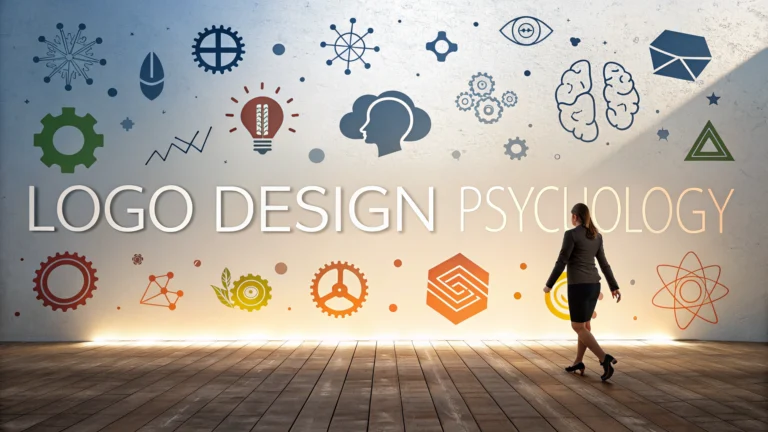Logo design psychology shapes how customers perceive and connect with your brand.
Color choices in logos trigger specific emotional responses – red creates excitement and urgency, blue builds trust, while green often represents growth and nature.
Key Elements of Logo Psychology
- Shapes: Circular designs convey community and unity
- Lines: Vertical lines suggest strength and stability
- Fonts: Serif fonts communicate tradition, while sans-serif appears modern
- Space: Negative space can create clever hidden meanings
Color Psychology in Logo Design
| Color | Psychological Effect | Common Usage |
|---|---|---|
| Red | Energy, passion | Food, entertainment |
| Blue | Trust, security | Banking, technology |
| Yellow | Optimism, clarity | Food, retail |
Shape Psychology Tips
- Squares and rectangles suggest stability and professionalism
- Triangles indicate direction and progress
- Organic shapes create emotional connections
Simple designs typically perform better than complex ones, as they’re more memorable and versatile.
Practical Application Guidelines
- Research your target audience’s cultural associations with colors and shapes
- Test your logo in different sizes and contexts
- Ensure it works in both color and black-and-white
- Consider how it will appear on different materials and screens
A successful logo should remain effective and recognizable even when scaled down to 16×16 pixels.
Common Logo Design Mistakes to Avoid
- Following trends blindly instead of focusing on timeless design
- Using too many colors or fonts
- Creating overly complex designs
- Copying other brands’ styles
The most effective logos combine psychological principles with clear brand messaging.
Professional Resources
Testing your logo design with focus groups can provide valuable insights into its psychological impact.
Impact of Logo Psychology on Brand Success
Research shows that consumers form first impressions of a brand within 7 seconds, making logo psychology crucial for market success.
Cultural Considerations
- Colors have different meanings across cultures
- Symbols may carry varying significance globally
- Some shapes could be considered offensive in certain regions
- Language and text direction affect logo placement
Digital Age Adaptations
Modern logos must function effectively across multiple platforms and devices:
- Social media profile pictures
- Mobile app icons
- Website favicons
- Digital advertising
Measuring Logo Effectiveness
- Brand recognition rates
- Consumer emotional response
- Cross-platform visibility
- Memorability tests
Conclusion
Successful logo design requires a deep understanding of psychology, cultural awareness, and practical application. Businesses that invest in psychologically informed logo design often see improved brand recognition and customer loyalty. Regular evaluation and subtle updates ensure logos remain relevant while maintaining their core psychological impact.
Remember that logo psychology isn’t just about aesthetic appeal—it’s about creating meaningful connections with your target audience that stand the test of time.
FAQs
- How does color psychology influence logo design?
Colors evoke specific emotions and associations – red represents energy and passion, blue suggests trust and reliability, green symbolizes growth and nature, yellow conveys optimism and warmth, and purple implies luxury and royalty. - What makes a logo memorable from a psychological perspective?
Memorable logos utilize simplicity, unique shapes, appropriate symbolism, and maintain visual hierarchy while creating cognitive anchors through distinctive design elements that are easy to recall. - Why do many successful brands use simple geometric shapes in their logos?
Simple geometric shapes are psychologically processed faster by the human brain, making them more memorable and recognizable. They also convey stability, order, and professionalism. - How does negative space affect logo perception?
Negative space creates visual interest, adds layers of meaning, and engages viewers’ minds through clever design techniques that make logos more engaging and memorable, like the arrow in FedEx’s logo. - What role does font psychology play in logo design?
Font choice influences brand perception – serif fonts convey tradition and reliability, sans-serif suggests modernity and simplicity, script fonts communicate elegance and creativity, while display fonts can express uniqueness and personality. - How do symmetry and balance impact logo effectiveness?
Symmetrical and balanced logos are perceived as more stable and trustworthy because humans naturally prefer visual equilibrium, which creates a sense of harmony and professionalism. - What psychological effect does logo size and scalability have?
Logos must maintain visual impact at different sizes to ensure consistent brand recognition. Simpler designs scale better and create stronger psychological imprints across various applications. - How does cultural context influence logo interpretation?
Cultural symbols, colors, and shapes carry different meanings across cultures. Successful logos consider these variations to avoid negative associations and ensure positive reception in global markets. - Why do some brands periodically update their logos?
Logo updates reflect evolving consumer psychology, market trends, and brand positioning while maintaining core recognition elements to stay relevant and maintain psychological connection with audiences. - How does the Gestalt principle affect logo design?
Gestalt principles like closure, continuity, and proximity influence how viewers perceive and process logos, helping create cohesive designs that the brain naturally completes and understands.








